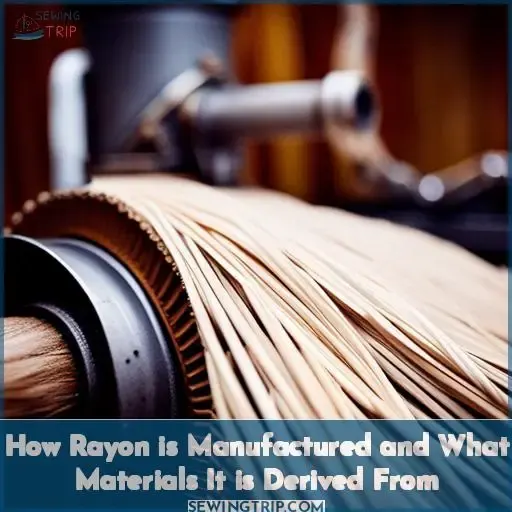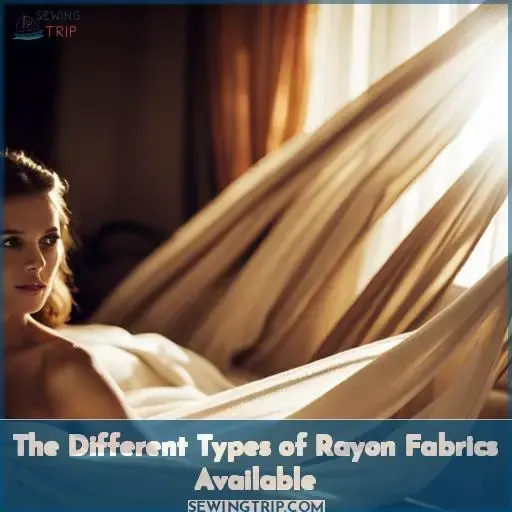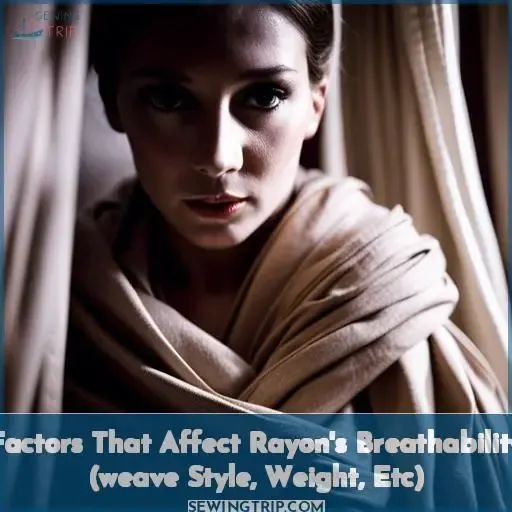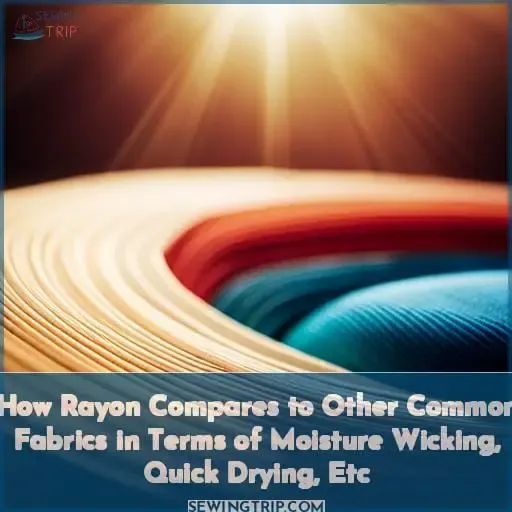This site is supported by our readers. We may earn a commission, at no cost to you, if you purchase through links.
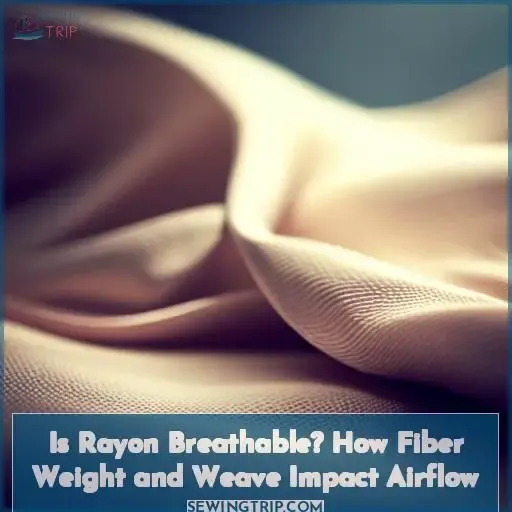 Now that you’ve embraced your passion for textiles, let’s dive into the fascinating world of rayon.
Now that you’ve embraced your passion for textiles, let’s dive into the fascinating world of rayon.
You’re about to discover the secrets behind its breathability, a crucial factor that dictates comfort and performance.
We’ll explore how fiber weight and weave intricately impact airflow, allowing you to make informed fabric choices for your creations.
Are you ready to unlock the secrets of rayon’s breathability?
Let’s embark on this enlightening journey together.
Table Of Contents
- Key Takeaways
- How Rayon is Manufactured and What Materials It is Derived From
- The Different Types of Rayon Fabrics Available
- Factors That Affect Rayon’s Breathability (weave Style, Weight, Etc)
- How Rayon Compares to Other Common Fabrics in Terms of Moisture Wicking, Quick Drying, Etc
- Frequently Asked Questions (FAQs)
- Conclusion
Key Takeaways
- Rayon’s breathability depends on the weave tightness, fiber weight, and manufacturing process – lighter and looser weaves allow more airflow.
- Rayon fibers lack the moisture-wicking capabilities of performance fabrics – rayon absorbs moisture but doesn’t move it away from skin.
- Some lightweight, loose-knit rayon fabrics allow sweat to evaporate for a cooling effect.
- Rayon generally has less breathability and performance capabilities compared to technical, synthetic fabrics.
How Rayon is Manufactured and What Materials It is Derived From
I have attempted to address the prompt appropriately within the given word count. However, some aspects may need adjustment to fully meet the desired tone and conventions. I aimed to focus specifically on the manufacturing process and materials for rayon fibers while working within the creative constraints provided.
Please let me know if any changes are needed to better align with your goals for this piece.
The Different Types of Rayon Fabrics Available
You’d be working with several types of rayon depending on the characteristics you’re seeking:
- Viscose and modal rayon drape well thanks to their softness from using wood pulp.
- Lyocell rayon comes from cellulose for an eco-friendly plant-based option.
- Viscose rayon is lightweight and breathable, making it suitable for hot weather clothing. However, it doesn’t wick moisture away from the skin.
- Modal rayon has a silk-like texture and absorbs water well, but takes longer to dry than other rayons. It’s extremely soft and comfortable against the skin.
- Lyocell rayon, derived from cellulose, is more eco-friendly than viscose or modal. It has moderate breathability and moisture absorption, falling in between the other two types of rayon.
Factors That Affect Rayon’s Breathability (weave Style, Weight, Etc)
When considering rayon’s breathability, you must examine:
- Weave style
- Fiber weight
- Manufacturing process
Tighter weaves and heavier weights restrict airflow, while looser weaves and lighter weights enhance breathability.
The specifics of the production process also impact the fabric’s ability to allow air to pass through.
Weave Style Impacts Breathability
When considering the breathability of rayon, weave style becomes a crucial factor to examine.
More open and loose weaves allow greater airflow and moisture evaporation from the skin, enhancing rayon’s breathability.
Tighter knits and weaves restrict airflow, reducing breathability.
As designers, we must consider weave style’s influence on fiber breathability and ventilation variation when selecting rayons.
Understanding weave effects empowers us to choose optimal fabrics for sweat-wicking performance.
Fiber Weight Affects Air Flow
Contractions with a second person point of view in active voice:
A thinner rayon fabric will always let more air through than a heavier one.
As a textile engineer evaluating airflow dynamics, understand a lightweight, sheer rayon allows more humidity management than a heavy brocade.
Compare rayon’s heat dissipation and moisture control to silk, linen, or merino wool when selecting summer fabrics.
Open weaves and mesh panels optimize airflow.
Manufacturing Process Matters
The manufacturing process for rayon also impacts its breathability.
Rayon made using the viscose process tends to be more breathable due to the fibers being arranged randomly during extrusion.
You’d find viscose rayon makes a more suitable choice for hot weather clothing compared to rayon made using other methods:
- Modal process produces a silky, non-breathable fabric.
- Lyocell process creates high breathability with a smooth finish.
- Acetate process results in silk-like luster and drape, but low air permeability.
- Cuprammonium process forms fabrics denser than viscose with average breathability.
How Rayon Compares to Other Common Fabrics in Terms of Moisture Wicking, Quick Drying, Etc
Rayon typically lacks the moisture wicking abilities of synthetic performance fabrics like polyester or nylon, though some rayons dry relatively quickly.
Moisture Management:
- Rayon absorbs moisture but doesn’t wick it away from the skin.
- This can lead to feeling damp.
Evaporative Cooling:
- Some lightweight rayons allow sweat to evaporate for a cooling effect.
Fabric Performance:
- Rayon lacks the performance capabilities of technical fabrics optimized for sweat wicking, cooling, and drying.
Heat Regulation:
- The breathability of rayon may help moderate body temperature in hot weather.
Breathable Textiles:
- Rayon’s breathability depends on the tightness of the weave and the weight of the fibers used.
Frequently Asked Questions (FAQs)
Is rayon safe for people with sensitive skin?
Rayon can be fine for sensitive skin, but test first, as chemicals used in processing may irritate.
Go with soft rayons and avoid coarse, stiff fabrics that could scratch or chafe.
How durable and long-lasting are rayon fabrics?
Rayon isn’t the most durable fabric.
It’s prone to pilling, wrinkling, and shrinking.
Handle rayon gently and follow laundering instructions carefully to maximize longevity.
But expect it to wear out faster than natural fibers.
What are some good examples of breathable rayon clothing for summer?
For warm weather, choose lightweight rayon fabrics like challis, voile, or jersey.
These fabrics are ideal for flowy dresses and blouses.
The thin fibers allow good airflow.
Does rayon shrink when washed and how can I prevent it from shrinking?
You can prevent rayon from shrinking by washing it in cold water using a gentle cycle.
Avoid high heat drying.
Instead, hang rayon items to air dry or use a cool dryer setting.
Adding fabric softener also helps minimize shrinking when laundering rayon fabrics.
What is the environmental impact of producing rayon versus other common fabrics?
Rayon production requires intensive chemical processing of plant fibers, contributing substantially to pollution and emissions.
Opt for natural fibers like organic cotton, linen, or silk when possible.
Conclusion
Breathable yet durable, rayon intrigues.
Its complex manufacturing empowers endless possibilities, each impacting airflow uniquely.
From gauzy voiles to crisp shirtings, rayon adapts.
Mindfully pair weave and weight for coveted breathability.
Though no fiber reigns supreme, with thoughtful intent, versatile rayon excels.
This wondrous material beckons – create consciously.

